It was a bit of a shocker, even by New York City standards: a front-page story in the New York Times headlined, “A Mayoral Hopeful Now, de Blasio Was Once a Young Leftist.” This was barely 10 days after Bill de Blasio’s incredible -from-behind victory in the Democratic primary election for Gotham’s top job.
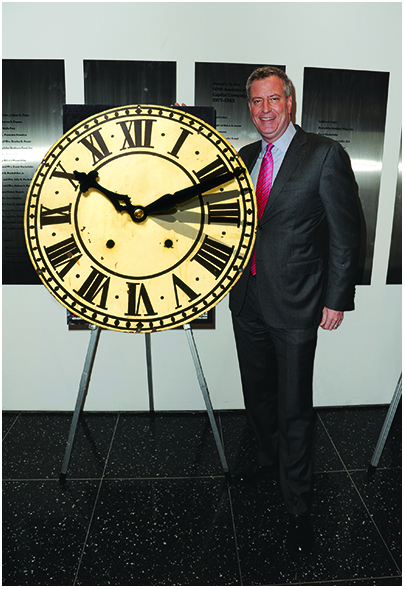
“The scruffy young man who arrived in Nicaragua in 1988 stood out,” the story begins. “Bill de Blasio, then 26, went to Nicaragua to help distribute food and medicine in the middle of a war between left and right.” A few paragraphs later, the reporter, Javier C. Hernández, drops the bomb: “Mr. de Blasio …grew to be an admirer of Nicaragua’s ruling Sandinista party, thrusting himself into one of the most polarizing issues in American politics at the time.”
Would this be Bill de Blasio’s Bill Ayers moment? Would the other shoe drop?
It didn’t. Even though the New York Post weighed in the next day with a story that ACORN, the discredited Far Left activist group, had been “plotting for more than a decade to install Bill de Blasio at City Hall,” nothing happened.
In fact, de Blasio increased his lead over Republican opponent Joe Lhota, from 43 points to 49 (68 to 19) after the revelation. (He would win the November 5 general election by an astounding 73 to 24 percent.)
While heads were spinning, policy watchers seemed genuinely perplexed by de Blasio’s education opinions. The new front-runner had made statements—“It is insult to injury to give [charters] free rent,” he told an education forum in the summer—that sent chills up the charter school movement’s spine. He also said he would stop giving schools grades of A to F, a signature accountability initiative of the Bloomberg-Klein era (Joel Klein was Mayor Michael Bloomberg’s schools chancellor between 2002 and 2010). De Blasio opposes many of Bloomberg’s reform efforts despite the achievement gains realized by the nation’s largest school district during the last 12 years (see Figure 1).
Yet on close reading, de Blasio’s nine-page education plan offers mostly bromides and impossible dreams: “ensure that all students are reading at grade level by third grade,” “reduce class size,” “involve and engage parents and families,” and “place great leaders to lead great teachers in every school.” The proposal that has gotten him the most attention—universal pre-K—has done so not because of the education part but because of the payment plan: a tax on those making more than $500,000.
Competing depictions of Mayor de Blasio—that he’s an enemy of Bloomberg-style education reform and that he’s more of a pragmatist than his anti-Bloomberg rhetoric suggests—have split education reformers into two camps: the fearful and the hopeful.
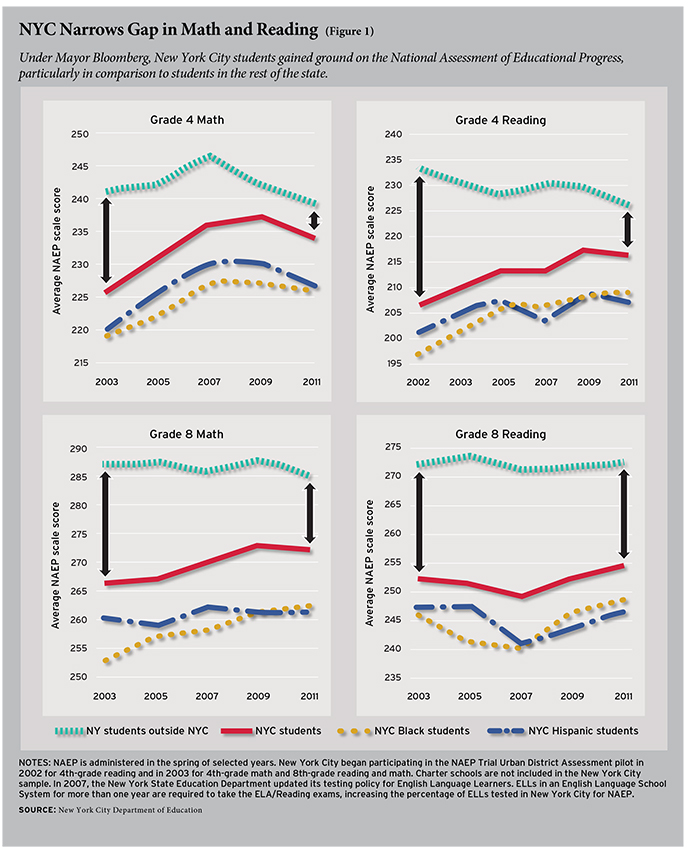
A Question of Choice
The Daily News calls it a plan “to kill city charter schools by a thousand cuts.” De Blasio has said that he would cap their numbers, stop letting them share space with traditional public schools, and start charging rent for existing colocations. The Democratic mayor’s public comments against charters, among the most significant of the Bloomberg reforms, have convinced many reformers that de Blasio is a real threat to continued progress in the city’s schools.
Stopping colocation or charging rent for space would be “absolutely catastrophic,” Joel Klein told me. “It’s not just bad for the charters, but for the children…. Charter schools are public in every meaningful way…. The public schools don’t pay rent, the charter schools, which are serving the same kids, shouldn’t pay rent.”
“Colocations are a fiscal necessity for New York’s charters,” according to education professor and Manhattan Institute senior fellow Marcus Winters, “since they get no capital funds from the state.”
A new report by Grover “Russ” Whitehurst and the Brown Center on Education Policy at the Brookings Institution says that the “expansion of school choice and school competition” has been a “prominent dimension of change” since Bloomberg won control of the schools in 2002. (De Blasio says he supports mayoral control.) Using their new authority, Bloomberg and Klein “dramatically” expanded the “availability of alternatives” to failing public schools, increasing charters from 14 schools to 159 during Bloomberg’s three terms, closing failing schools, and making almost all of the city’s high schools “schools of choice” (see Figure 2).
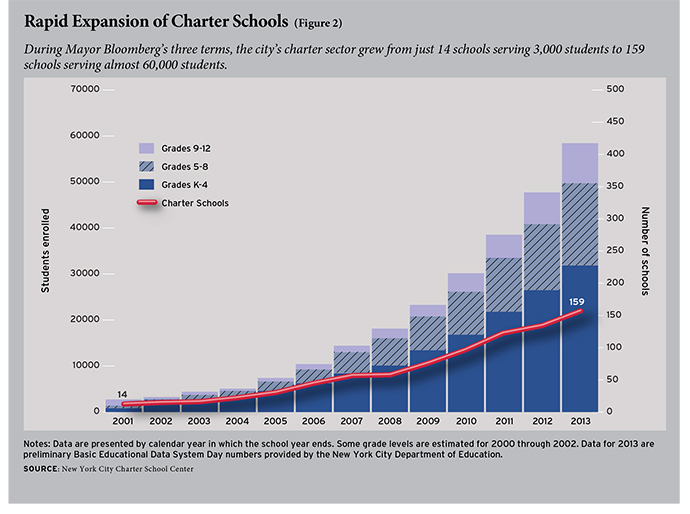
While de Blasio has criticized school closings, he fails to mention that Bloomberg and Klein opened some 60 new schools each year, a number that includes 123 small, nonselective high schools “intended to serve students in the city’s poorest neighborhoods.”
And the evidence that those small high schools work? According to both Brookings and a separate report by MDRC, graduation rates for the city’s students rose by 18 percentage points during the Bloomberg-Klein era, double the rate for schools in the rest of the state. In the small high schools, graduation rates were 9.5 percentage points higher than for students attending other NYC schools.
Today, nearly 20 percent of NYC’s school population, some 200,000 students, “are being served by schools that came into existence during the Bloomberg administration,” according to Brookings. And parents want more: 53,000 students are on charter school waiting lists.
A 2009 study by economist Caroline Hoxby found that students in the city’s charter schools made substantially better academic progress than they would have in a traditional public school. Stanford University’s Center for Research on Education Outcomes (CREDO) found that NYC charter students gained an additional one month of learning per year in reading over their district-school peers; in math the advantage was five months of additional learning each year.
“These are very large effects,” concludes the Brookings report.
The empirical research, says Winters, “leaves no doubt that the average student who attends a Gotham charter is much better off because of it.” In a separate 2009 study, Winters also found that “the more students a public school lost to charters, the better its remaining students performed—probably because the school now faced competition from charters for enrollment.”
All in all, this paints a devastatingly clear picture of de Blasio’s wrong turn on one of the city’s most important education reforms.
And so it was that the state’s highest-ranking education official, chancellor of the New York State Board of Regents Merryl Tisch, chided de Blasio for his views. “Charter schools are public schools,” Tisch told the Daily News. “What do they do with their money? Extra-long school day, extra-long school year, science labs. They wire the classrooms. They offer art, music, enriched programs. They are giving a service to the kids in New York City.”
Finally, she said bluntly, “To make New York City not hospitable to the charter school movement is to hurt efforts at fixing the school system.”
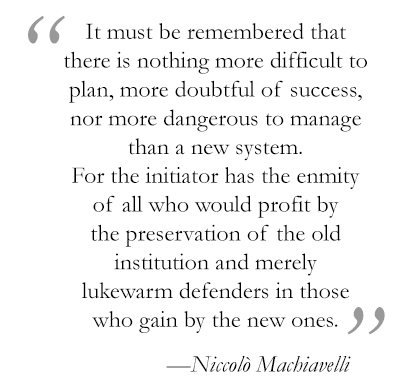 The Dexterous Pol
The Dexterous Pol
There is evidence that de Blasio is listening, at least well enough to bob and weave.
De Blasio is an expert political strategist, an obvious fact since he jumped from third place in primary polls to a commanding victory in just a few weeks. He not only caught the importance of Bloomberg fatigue in the electorate, he elevated it to a campaign message that stuck: a tale of two cities. He added the inequality gap, the frozen wheels of the social mobility crisis, and the stop-and-frisk judicial setback for the billionaire mayor to build an anti-Bloomberg offense that left the other candidates reeling. On education, de Blasio’s critique employed the two-cities theme: he emphasized inclusiveness and equity, playing a populist to counter a member of the aristocracy. He touted high-quality schools in “every neighborhood,” “truly universal” pre-K, “increasing parental engagement,” “additional venues for parents to relay their concerns,” “providing a voice” for students with disabilities, creating more “community schools.” In this atmosphere, it mattered less that the billionaire mayor had made good on his promise to fix a failing school system than that he was a billionaire.
It may be style over substance, but the populist poetry worked. And since de Blasio was not endorsed by the powerful teachers union, his victory left some reformers wondering whether de Blasio was, as the Thomas B. Fordham Institute’s Mike Petrilli wrote, “untethered from both the 1 percent and organized labor.”
This hypothesis was put to the test in the summer, when de Blasio was running a weak third place in polls of Democratic voters. David Steiner, the former commissioner of education for New York State and now dean of Hunter College’s School of Education, quizzed him for nearly an hour during an event sponsored by Steiner’s new CUNY Institute for Education Policy. (Disclosure: I am program manager at the institute and introduced de Blasio at that event.) Steiner pushed the candidate on several fronts.
“Under the Bloomberg-Klein administration, high school graduation rates are up,” Steiner told de Blasio before an audience of nearly 100 teachers, policymakers, and members of the public. “The dropout rate is down. Yet, you have said, and I quote, ‘The lights are out, no one is listening at Tweed.’” (One of Bloomberg’s first “reforms” was closing the city’s department of education headquarters in Brooklyn and moving it to the restored Tweed Courthouse, located just behind City Hall.) “And you’ve called for fundamental change from the Bloomberg administration. How do I put those two things together?”
“I’ll give you an easy way to put them together,” de Blasio replied with an impressive lack of hesitation that was also uncannily responsive. “The particularly narrow, un-inclusive, un-consultative way in which the Bloomberg administration approached it is not the only way to do it. So when I said the lights are out, I am saying Tweed is a single building that is essentially impossible to access if you are an average parent, making decisions about 1.1 million school children. That to me means…there is no feedback loop, and there is very little ability for people to register their concerns and needs.”
And on charters? “You are obviously on record as being very discouraging, if I could use that word, of further expansion of charter schools,” Steiner told de Blasio.
“Let me recast,” de Blasio countered. “There are some very good charter schools, and I’m glad we have them. There are some that have not done well, and I think part of the challenge until the very end of the Bloomberg years was acknowledging the fact that they are mortal….” Et cetera. De Blasio eventually moved back to safe ground, his narrative. “Our central task for the future of our city is to address the challenges of the traditional public school.”
A Seasoned Player
So, the question is twofold, well, threefold: is de Blasio an enemy of school reform, does he speak with forked tongue, or, if not, does he have the governance mettle to do the right thing when he sees it?
De Blasio claims to have decided to enter public life when he was 12 years old, watching Watergate unfold. It was, he would say later, “the greatest morality play in the history of American politics.” After attending Rindge and Latin High School, a public school in Cambridge, Massachusetts, he earned a BA in political science from New York University and a master’s degree in international affairs from Columbia. Following his stint in Nicaragua, de Blasio became a junior staffer for mayor David Dinkins (1990–1993). As a regional director in the U.S. Department of Housing and Urban Development (working for Andrew Cuomo, then secretary of HUD) under Bill Clinton, he earned the respect of the Clintons, who put de Blasio in charge of Hillary’s successful campaign for the U.S. Senate in 2000.
De Blasio possesses “real strategic sense and smarts about politics,” says Harold Ickes, a former top aide to President Clinton, who picked de Blasio to manage Hillary’s Senate campaign.
De Blasio’s own political career began with a slot on the Community School Board for District 15, then a seat on the New York City Council, where he spent eight years representing Brooklyn (2001 to 2009). In 2009 he won a bruising citywide election for Gotham’s second-ranked public official (after the mayor), the public advocate, which Manhattan Institute fellow Sol Stern says, “is a campaign office” for mayor.
And here we are. A seasoned, “inside institutional player,” as Joe Williams, former Daily News reporter and current head of Democrats for Education Reform, describes him, is the new mayor of New York City.
“I think Bill’s made a political calculation that being the antagonist to Bloomberg in the race is his best positioning,” Bloomberg’s deputy mayor Howard Wolfson told the New York Observer in late 2012, before de Blasio had even declared his candidacy. “He’s been in politics for a very long time as an operative, so I know that he would have thought about that pretty hard.”
Williams, a determined reformer and unadulterated supporter of the Bloomberg reforms, says de Blasio is “going to try to find ways to keep all of his constituencies, not necessarily happy, but feeling like they’re part of the process.”
Does that mean he’s already running for his second term? De Blasio dropped a lot less red meat about education after he became the runaway front-runner, giving skeptical reformers their first reason for hope: perhaps de Blasio is a practiced pol but not an ideologue. And isn’t that better than a dyed-in-the-wool liberal?
“Thousands and thousands of charter school parents are militantly protective of their schools,” said Chris Cerf in a phone interview not long after de Blasio’s primary victory. Cerf, currently commissioner of education in New Jersey, served as a deputy chancellor to Klein from 2004 to 2009, during one of the most turbulent periods in the city’s education history. “This gives me a great deal of confidence that most of the work done there will survive.”
Five days after our conversation, the New York Times released a poll showing that 56 percent of voters (61 percent of blacks and 50 percent of whites) wanted more charters. And a week after that, several thousand charter-school supporters marched across the Brooklyn Bridge to oppose de Blasio’s anticharter comments, recounted in the Times under the headline, “City’s Charter Schools Fear Having de Blasio for a Landlord.”
“His aides said he was not looking to overturn all of Mr. Bloomberg’s educational policies,” reported Javier Hernández in the Times the day after the Brooklyn Bridge march. “In recent weeks, he has arranged meetings with charter school advocates; in past conversations, he has sought to persuade them that he is not a zealot who will seek to drive their schools from the city.”
“On the question of fundamental change,” de Blasio told Steiner in August, “I think some of the achievements of the Bloomberg years…I applaud them, and I would build upon them.”
The New Status Quo
This brings us to a second reason some reformers have taken a wait-and-see attitude toward de Blasio. The changes made by Bloomberg and Klein may simply be too deep and wide and popular to roll back.
“There’s a wonderful quote from Machiavelli,” says Cerf, “where he says, basically, that the defenders of the status quo always have a much easier job than those who are trying to change it. And in the last 12 years, Bloomberg actually created a new status quo, with many defenders of a new order.”
On the question of school closings, for instance, Michele Cahill, a Carnegie Corporation education specialist who masterminded the small–high schools initiative for Klein, believes that the discussion lately “has gotten very stuck in issues of participation and decision making.” Now back at the Carnegie Corporation, where she is vice president for national programs and director of urban education, Cahill too believes that these Bloomberg- Klein reforms will not be easily reversed. “Small schools is not an initiative,” she emphasizes. “There are several hundred high schools now that are functioning in New York, and they have students and teachers and parents who affiliate with them and are showing tremendous results.”
This leads to the third reason for optimism in the reform ranks: the next mayor may be more constrained by factors that he can’t control than by his beliefs.
He might not have time or resources to do much dismantling, or building. First, there’s Albany. Public school districts in New York State are creatures of the state legislature and, technically, governed by the Board of Regents. A new tax, to pay for universal pre-K, for example, must be approved by the legislature. Albany also dictates both testing and teacher evaluations. De Blasio can promise change, but a determinedly reformist and antitax legislature will most probably tie his hands.
Then there’s the “fiscal cliff,” or as Steven Malanga, senior fellow at the Manhattan Institute, said, “no matter who wins the election, one of them is going to wake up to a fiscal nightmare.” Cliff or nightmare, Malanga says that the city’s budget nearly doubled during Bloomberg’s tenure, rising from $28.9 billion to $47.5 billion by 2012, and “may finally have outstripped the Wall Street–generated tax revenues that have made such profligacy possible. The next mayor won’t have the luxury of expanding the government; instead, he’ll have to figure out how to pay for one that’s already dangerously bloated.” Most of the new spending, says Malanga, went to “rising compensation, especially benefits, for government employees,” another hand-tying situation (see Figure 3).
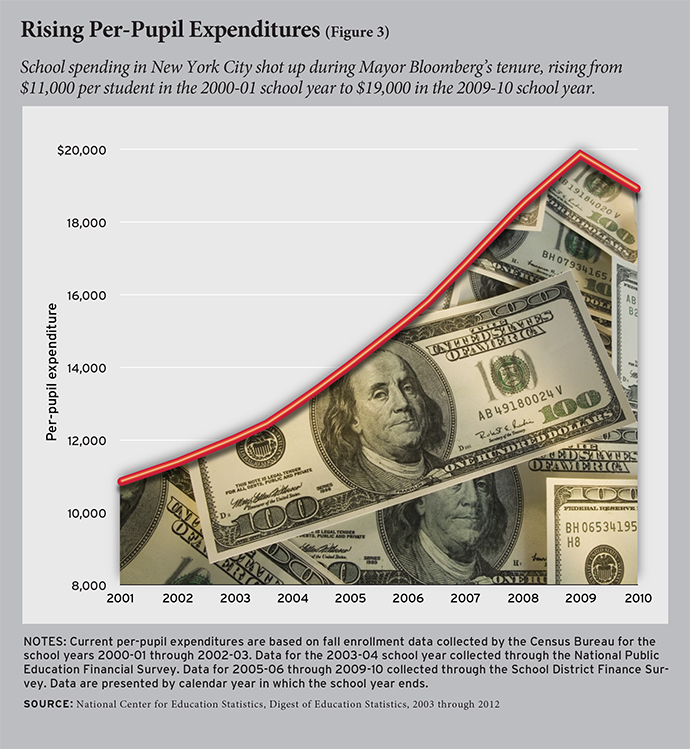
One of those compensation questions will be a teachers union contract that is now several years expired. Teachers will want back pay for salary increases, which would cost several billion dollars. But de Blasio also has an Absent Teacher Reserve pool to deal with, another Bloomberg-Klein legacy: they got the union to back down on forcing principals to hire teachers they didn’t want, “one of the only good things to come out of the last contract negotiations,” says Joe Williams. But they did not resolve the issue of what to do with those unwanted teachers. “Right now they’re paying a couple hundred million dollars a year to teachers who are not teaching and that nobody wants in their classrooms,” says Williams. “That’s money that could go to pay raises for teachers.”
These constraints bode well for Cerf’s Machiavellian hypothesis, although the downside for charter operators in these fiscally constrained times is that the new mayor will be even more tempted to charge them rent.
The Legacy and the Future
Debate continues about the strength of the new status quo. Sol Stern believes that Cerf is “underestimating the anger and potential revolt among ordinary teachers who he never talks to.” But there is little doubt that the school system the new mayor inherited from Michael Bloomberg on January 1, 2014, is not the system Bloomberg got on January 1, 2002.
Bloomberg and Klein “proved the important point that it is possible to change big and bulky school bureaucracies,” says Jeffrey Henig, professor of political science and education at Columbia. “They also brought in a lot of motivated young talent, and seem to have made the system more professional and efficient.”
“They unfroze a system that was totally immobile,” adds Joseph Viteritti, professor of public policy at Hunter College. “They added mobility to a system that, for years, those of us who followed it said can’t be moved. That was an enormous accomplishment.”
In the end, the Bloomberg-Klein legacy may simply be that it cleared the way for de Blasio to do just what the Brown Center report said he should do: the right thing. Thanks to Bloomberg, he has the power.
Good luck, Next Mayor.
Peter Meyer is program manager at the CUNY Institute for Education Policy, senior fellow at the Thomas B. Fordham Institute, and contributing editor at Education Next.
This article appeared in the Spring 2014 issue of Education Next. Suggested citation format:
Meyer, P. (2014). Will Mayor de Blasio Turn Back the School Reform Clock? New York City’s charters and small high schools at risk. Education Next, 14(2), 18-25.


